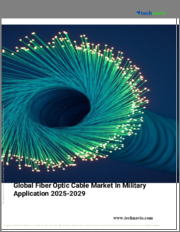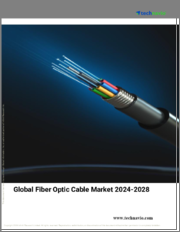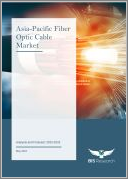
|
시장보고서
상품코드
1488097
광섬유 케이블 제조 플랜트 프로젝트 보고서(2024년) : 산업 동향, 플랜트 설립, 기계, 원재료, 투자 기회, 비용, 수익Fiber Optic Cable Manufacturing Plant Project Report 2024: Industry Trends, Plant Setup, Machinery, Raw Materials, Investment Opportunities, Cost and Revenue |
||||||
IMARC Group이 발행한 "광섬유 케이블 제조 플랜트 프로젝트 보고서(2024년) : 산업 동향, 플랜트 설립, 기계, 원재료, 투자 기회, 비용, 수익" 보고서는 광섬유 케이블 제조 플랜트 설립을 위한 완벽한 로드맵을 제공합니다. 종합적인 시장 개요에서 관련 단위 작업, 원재료 요구 사항, 유틸리티 요구 사항, 인프라 요구 사항, 기계 및 기술 요구 사항, 인력 요구 사항, 포장 요구 사항 및 운송 요구 사항과 같은 미시적 수준의 정보까지 포괄합니다. 광섬유 케이블 프로젝트 보고서는 자본 투자, 프로젝트 자금, 운영비, 손익 예측, 고정비 대 변동비, 직접비 및 간접비, 예상 ROI 및 순현재가치(NPV), 손익 계산, 재무 분석 등 프로젝트 경제에 대한 자세한 인사이트를 제공합니다.
본 보고서에서 다루는 주요 질문
- 광섬유 케이블 시장은 지금까지 어떻게 발전해 왔으며 향후 몇 년 동안 어떻게 발전할 것인가?
- 세계 광섬유 케이블 시장의 시장 세분화는?
- 세계 광섬유 케이블 시장의 지역별 분류는?
- 광섬유 케이블 업계의 각종 원재료 가격 동향은?
- 광섬유 케이블 산업의 구조와 주요 업체는?
- 광섬유 케이블 제조 플랜트에서 이루어지는 다양한 단위 작업은 무엇인가?
- 광섬유 케이블 제조 플랜트 설립에 필요한 총 면적은 얼마인가?
- 광섬유 케이블 제조 플랜트의 레이아웃은 어떻게 되는가?
- 광섬유 케이블 제조 플랜트 건설에 필요한 기계는 무엇인가?
- 광섬유 케이블 제조 플랜트 건설에 필요한 원재료는?
- 광섬유 케이블 제조 플랜트 설립에 필요한 포장재는 무엇인가?
- 광섬유 케이블 제조 플랜트 설립에 필요한 운송은?
- 광섬유 케이블 제조 플랜트 설립에 필요한 유틸리티는?
- 광섬유 케이블 제조 플랜트 설립에 필요한 인적 자원은?
- 광섬유 케이블 제조 플랜트 설립에 필요한 인프라 비용은?
- 광섬유 케이블 제조 플랜트 설립에 드는 자본 비용은?
- 광섬유 케이블 제조 플랜트 설립을 위한 운영비용은?
- 최종 제품의 가격 메커니즘은 어떻게 해야 하는가?
- 광섬유 케이블 제조 플랜트의 손익은 어떻게 되는가?
- 수지를 맞추는 데 필요한 시간은?
- 광섬유 케이블 제조 플랜트 설립에 따른 수익 예측은?
- 광섬유 케이블 산업의 주요 성공요인과 위험요인은 무엇인가?
- 광섬유 케이블 제조 플랜트 설립에 필요한 주요 규제 절차와 요구 사항은 무엇인가?
- 광섬유 케이블 제조 플랜트 설립에 필요한 주요 인증은 무엇인가?
목차
제1장 서문
제2장 조사 범위와 조사 방법
- 조사 목적
- 이해관계자
- 조사 방법
제3장 주요 요약
- 시장 동향
- 원재료 수요
- 수입 예측
- 지출 예측
- 이익 분석
제4장 광섬유 케이블 세계 시장
- 시장 개요
- 과거와 현재의 시장 동향
- COVID-19의 영향
- 부문별 시장 내역
- 지역별 시장 내역
- 가격 동향
- 시장 전망
- 경쟁 상황
제5장 상세한 프로세스 플로우
- 제품 개요
- 다양한 단위 조작
- 품질 보증 기준
- 기술 시험
- 매스 밸런스와 원재료 요건
제6장 프로젝트 상세, 요건 및 관련 비용
- 토지, 입지, 부지 개발
- 플랜트 레이아웃
- 플랜트 기계
- 원재료
- 포장
- 수송
- 유틸리티
- 인재 요건과 임금
제7장 융자와 자금 원조
제8장 프로젝트 경제학
- 프로젝트 자본 비용
- 기술 경제 파라미터
- 수입 예측
- 지출 예측
- 제품 가격과 마진
- 과세
- 감가상각
- 재무 분석
제9장 규제 절차와 승인
제10장 인증 요건
제11장 주요 성공요인과 위험요인
제12장 전략적 제안
제13장 성공한 벤처기업 사례 연구
ksm 24.06.07IMARC Group's report, titled "Fiber Optic Cable Manufacturing Plant Project Report 2024: Industry Trends, Plant Setup, Machinery, Raw Materials, Investment Opportunities, Cost and Revenue" provides a complete roadmap for setting up a fiber optic cable manufacturing plant. It covers a comprehensive market overview to micro-level information such as unit operations involved, raw material requirements, utility requirements, infrastructure requirements, machinery and technology requirements, manpower requirements, packaging requirements, transportation requirements, etc. The fiber optic cable project report provides detailed insights into project economics, including capital investments, project funding, operating expenses, income and expenditure projections, fixed costs vs. variable costs, direct and indirect costs, expected ROI and net present value (NPV), profit and loss account, financial analysis, etc.
Fiber optic cables represent a technological marvel that has revolutionized the way we transmit data and communicate. These slender strands of glass or plastic are at the heart of the world's high-speed internet, global telecommunications networks, and data transmission systems. Unlike traditional copper cables, fiber optics use pulses of light to transmit vast amounts of data over long distances with unprecedented speed and clarity. This innovation has not only accelerated the internet but also transformed industries, from telemedicine to finance.
They offer numerous advantages and versatile applications in modern communication networks. Firstly, they transmit data at incredibly high speeds, ensuring swift internet connectivity and seamless video streaming. Their immunity to electromagnetic interference and secure transmission makes them ideal for secure data transfer in banking and healthcare sectors. Fiber optics also cover long distances with minimal signal loss, making them essential for long-haul telecommunications and undersea cables. Moreover, their thin and lightweight design simplifies installation and reduces maintenance costs. Fiber optics are indispensable in industries like telecommunication, internet service providers, data centers, and beyond, powering our digital world with efficiency and reliability.
These cables have witnessed a surge in demand driven by several market drivers and trends. Firstly, the insatiable appetite for high-speed internet and data transmission has led to the widespread deployment of fiber optic networks. These cables offer unparalleled data transfer rates and low latency, making them indispensable for industries like telecommunications, cloud computing, and streaming services. Secondly, the increasing adoption of 5G technology has further fueled the demand for fiber optic cables. 5G networks need a dense network of small cells for effective coverage, and these cables provide the necessary backhaul infrastructure to support these cells, enabling the lightning-fast speeds promised by 5G. Moreover, the rising awareness of environmental concerns has led to the preference for fiber optics over traditional copper cables. Fiber optic cables are more energy-efficient and durable, reducing the requirement for frequent replacements and lowering the overall carbon footprint. Lastly, the ongoing trend of smart cities and IoT devices necessitates robust, high-capacity data transmission, making these cables an essential component in building the connected future. As technology continues to advance, the market is poised for sustained growth, underpinned by these influential drivers and trends.
The following aspects have been covered in the fiber optic cable manufacturing plant report:
Market Analysis:
Market Trends
Market Breakup by Segment
Market Breakup by Region
Price Analysis
Impact of COVID-19
Market Forecast
The report provides insights into the landscape of the fiber optic cable industry at the global level. The report also provides a segment-wise and region-wise breakup of the global fiber optic cable industry. Additionally, it also provides the price analysis of feedstocks used in the manufacturing of fiber optic cable, along with the industry profit margins.
Detailed Process Flow:
Product Overview
Unit Operations Involved
Mass Balance and Raw Material Requirements
Quality Assurance Criteria
Technical Tests
The report also provides detailed information related to the fiber optic cable manufacturing process flow and various unit operations involved in a manufacturing plant. Furthermore, information related to mass balance and raw material requirements has also been provided in the report with a list of necessary quality assurance criteria and technical tests.
Project Details, Requirements and Costs Involved:
Land, Location and Site Development
Plant Layout
Machinery Requirements and Costs
Raw Material Requirements and Costs
Packaging Requirements and Costs
Transportation Requirements and Costs
Utility Requirements and Costs
Human Resource Requirements and Costs
The report provides a detailed location analysis covering insights into the land location, selection criteria, location significance, environmental impact, expenditure, and other fiber optic cable manufacturing plant costs. Additionally, the report provides information related to plant layout and factors influencing the same. Furthermore, other requirements and expenditures related to machinery, raw materials, packaging, transportation, utilities, and human resources have also been covered in the report.
Project Economics:
Capital Investments
Operating Costs
Expenditure Projections
Revenue Projections
Taxation and Depreciation
Profit Projections
Financial Analysis
The report also covers a detailed analysis of the project economics for setting up a fiber optic cable manufacturing plant. This includes the analysis and detailed understanding of capital expenditure (CapEx), operating expenditure (OpEx), income projections, taxation, depreciation, liquidity analysis, profitability analysis, payback period, NPV, uncertainty analysis, and sensitivity analysis. Furthermore, the report also provides a detailed analysis of the regulatory procedures and approvals, information related to financial assistance, along with a comprehensive list of certifications required for setting up a fiber optic cable manufacturing plant.
Key Questions Answered in This Report:
- How has the fiber optic cable market performed so far and how will it perform in the coming years?
- What is the market segmentation of the global fiber optic cable market?
- What is the regional breakup of the global fiber optic cable market?
- What are the price trends of various feedstocks in the fiber optic cable industry?
- What is the structure of the fiber optic cable industry and who are the key players?
- What are the various unit operations involved in a fiber optic cable manufacturing plant?
- What is the total size of land required for setting up a fiber optic cable manufacturing plant?
- What is the layout of a fiber optic cable manufacturing plant?
- What are the machinery requirements for setting up a fiber optic cable manufacturing plant?
- What are the raw material requirements for setting up a fiber optic cable manufacturing plant?
- What are the packaging requirements for setting up a fiber optic cable manufacturing plant?
- What are the transportation requirements for setting up a fiber optic cable manufacturing plant?
- What are the utility requirements for setting up a fiber optic cable manufacturing plant?
- What are the human resource requirements for setting up a fiber optic cable manufacturing plant?
- What are the infrastructure costs for setting up a fiber optic cable manufacturing plant?
- What are the capital costs for setting up a fiber optic cable manufacturing plant?
- What are the operating costs for setting up a fiber optic cable manufacturing plant?
- What should be the pricing mechanism of the final product?
- What will be the income and expenditures for a fiber optic cable manufacturing plant?
- What is the time required to break even?
- What are the profit projections for setting up a fiber optic cable manufacturing plant?
- What are the key success and risk factors in the fiber optic cable industry?
- What are the key regulatory procedures and requirements for setting up a fiber optic cable manufacturing plant?
- What are the key certifications required for setting up a fiber optic cable manufacturing plant?
Table of Contents
1 Preface
2 Scope and Methodology
- 2.1 Study Objectives
- 2.2 Stakeholders
- 2.3 Research Methodology
3 Executive Summary
- 3.1 Market Trends
- 3.2 Raw Material Requirements
- 3.3 Income Projections
- 3.4 Expenditure Projections
- 3.5 Profit Analysis
4 Global Fiber Optic Cable Market
- 4.1 Market Summary
- 4.2 Historical and Current Market Trends
- 4.3 Impact of COVID-19
- 4.4 Market Breakup by Segment
- 4.5 Market Breakup by Region
- 4.6 Price Trends
- 4.6.1 Raw Material Price Trends
- 4.6.2 Fiber Optic Cable PriceTrends
- 4.6.3 Product Margins
- 4.7 Market Outlook
- 4.8 Competitive Landscape
- 4.8.1 Market Structure
- 4.8.2 Key Players
- 4.8.3 Profiles of Key Players
5 Detailed Process Flow
- 5.1 Product Summary
- 5.2 Various Types of Unit Operations Involved
- 5.3 Quality Assurance Criteria
- 5.4 Technical Tests
- 5.5 Mass Balance and Raw Material Requirements
6 Project Details, Requirements and Costs Involved
- 6.1 Land, Location and Site Development
- 6.1.1 Overview
- 6.1.2 Selection Criteria and Significance
- 6.1.3 Location Analysis
- 6.1.4 Project Planning and Phasing of Development
- 6.1.5 Environmental Impact
- 6.1.6 Land Requirement and Costs
- 6.2 Plant Layout
- 6.2.1 Overview
- 6.2.2 Importance and Essentials
- 6.2.3 Layout
- 6.2.4 Factors Influencing Layout
- 6.3 Plant Machinery
- 6.3.1 Machinery Requirements
- 6.3.2 Machinery Costs
- 6.3.3 Machinery Suppliers (Provided on Request)
- 6.3.4 Machinery Pictures
- 6.4 Raw Materials
- 6.4.1 Raw Material Requirements
- 6.4.2 Raw Material Details and Procurement
- 6.4.3 Raw Material Costs
- 6.4.4 Raw Material Suppliers (Provided on Request)
- 6.4.5 Raw Material and Final Product Pictures
- 6.5 Packaging
- 6.5.1 Packaging Overview
- 6.5.2 Packaging Requirements
- 6.5.3 Packaging Material Details and Procurement
- 6.5.4 Packaging Costs
- 6.5.5 Packaging Material Suppliers (Provided on Request)
- 6.6 Transportation
- 6.6.1 Transportation Overview
- 6.6.2 Transportation Requirements
- 6.6.3 Transportation Costs
- 6.7 Utilities
- 6.7.1 Energy Requirements and Costs
- 6.7.2 Water Requirements and Costs
- 6.7.3 Costs Related to Other Utilities
- 6.8 Human Resource Requirements and Wages
- 6.8.1 Total Human Resource Requirement
- 6.8.2 Salary Costs
- 6.8.3 Overview of Employee Policies
7 Loans and Financial Assistance
8 Project Economics
- 8.1 Capital Cost of the Project
- 8.2 Techno-Economic Parameters
- 8.3 Income Projections
- 8.4 Expenditure Projections
- 8.5 Product Pricing and Margins
- 8.6 Taxation
- 8.7 Depreciation
- 8.8 Financial Analysis
- 8.8.1 Liquidity Analysis
- 8.8.2 Profitability Analysis
- 8.8.2.1 Payback Period
- 8.8.2.2 Net Present Value
- 8.8.2.3 Internal Rate of Return
- 8.8.2.4 Profit and Loss Account
- 8.8.3 Uncertainty Analysis
- 8.8.4 Sensitivity Analysis
- 8.8.5 Economic Analysis



















